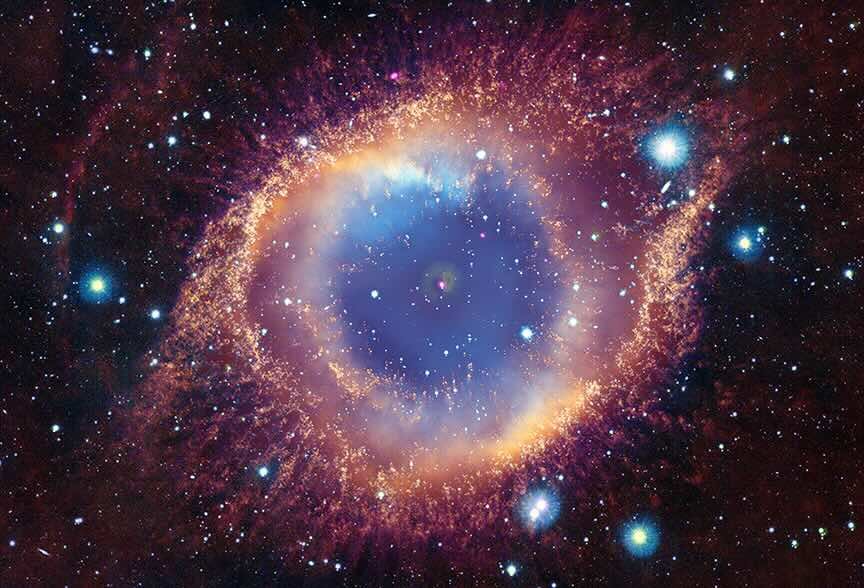The destruction of a planet inside a planetary nebula
Using observations from the Chandra Space Telescope, astronomers discovered that a well-known planetary nebula might have signs of planetary destruction.
Understanding Planetary Nebulae
Despite their name, planetary nebulae have little to do with planets. Instead, they represent one of the final chapters in a star’s life cycle. The term “planetary nebula” originated from their appearance—through early telescopes. These glowing objects resembled a disk like structure surrounding a central star. In reality, a planetary nebula features a bright central star, known as a white dwarf, encircled by a disk-shaped cloud of gas and dust. This “nebulosity” forms when a star, in its red giant phase, sheds its outer layers, revealing, in the end, the hot, dense core within.
Over years of observation, scientists have learned that the disk-like shape of these nebulae depends on our viewing angle. Some display lobes or irregular forms when seen from different directions.
A Planet’s Fate in the Helix Nebula
At the heart of the Helix Nebula—one of the closest and most studied planetary nebulae—lies a white dwarf known as WD2226−210. This star, classified as a hot, hydrogen-rich DAO white dwarf, boasts a scorching surface temperature of approximately 110,000 Kelvin. Because of their high temperatures, freshly formed white dwarfs like this one typically emit soft X-rays (with energies below ~0.5 keV). These X-rays will become weaker as the WD cools over time.
Curiously, over 40 years of observation, astronomers have found that WD2226−210 also emits more energetic X-rays, reaching energies around 1 keV—more intense than expected. In the mid-1990s, astronomers proposed that these energetic X-rays stemmed from shocked stellar winds within the Helix Nebula. However, later observations revealed the X-ray source was concentrated near the white dwarf, resembling a point rather than a diffuse cloud. This led to a new hypothesis: the X-rays might result from material accreting onto the star, possibly from a debris disk or the remnants of a disrupted planet.
Observations across multiple wavelengths—infrared, millimeter, and submillimeter—helped rule out competing theories. Data collected by the ROSAT, Chandra, and XMM-Newton telescopes between 1992 and 2002 showed that the X-ray brightness from WD2226−210 remained steady over decades. Yet, a closer look revealed a subtle, rhythmic fluctuation in the X-ray signal, repeating every 2.9 hours. This later clue suggests the presence of planetary remains orbiting remarkably close to the white dwarf.
A Jupiter-Like Planet’s Demise
In a recent study, researchers propose a compelling explanation for the steady emission and the fluctuations: the X-rays could trace back to the destruction of a massive planet, similar to Jupiter, that wandered too close to the white dwarf. As the planet approached, the star’s immense gravity likely tore it apart—partially or completely. The resulting debris would have formed a disk around the white dwarf, with fragments gradually spiraling inward and crashing onto the star’s surface. This process would account for the mysterious X-ray signals detected for decades.
This discovery not only reshapes our understanding of the Helix Nebula, but also offers new insight into planetary nebulae and the violent final fates that may await planets in the twilight of a star’s life.
This discovery not only reshapes our understanding of the Helix Nebula, but also offers new insight into planetary nebulae and the violent final fates that may await planets in the twilight of a star’s life.
Image Generated via -Grok3References:
S.Estrada-Dorado, M.A.Guerrero, J.A. Toalá, R. F.Maldonado, V. Lora, D. A.Vasquez-Torres, and Y.-H.Chu 2024, MNRAS
X-ray: NASA/CXC/SAO/Univ Mexico/S. Estrada-Dorado et al.; Ultraviolet: NASA/JPL; Optical: NASA/ESA/STScI (M. Meixner)/NRAO (T.A. Rector); Infrared: ESO/VISTA/J. Emerson; Image Processing: NASA/CXC/SAO/K. Arcand.

